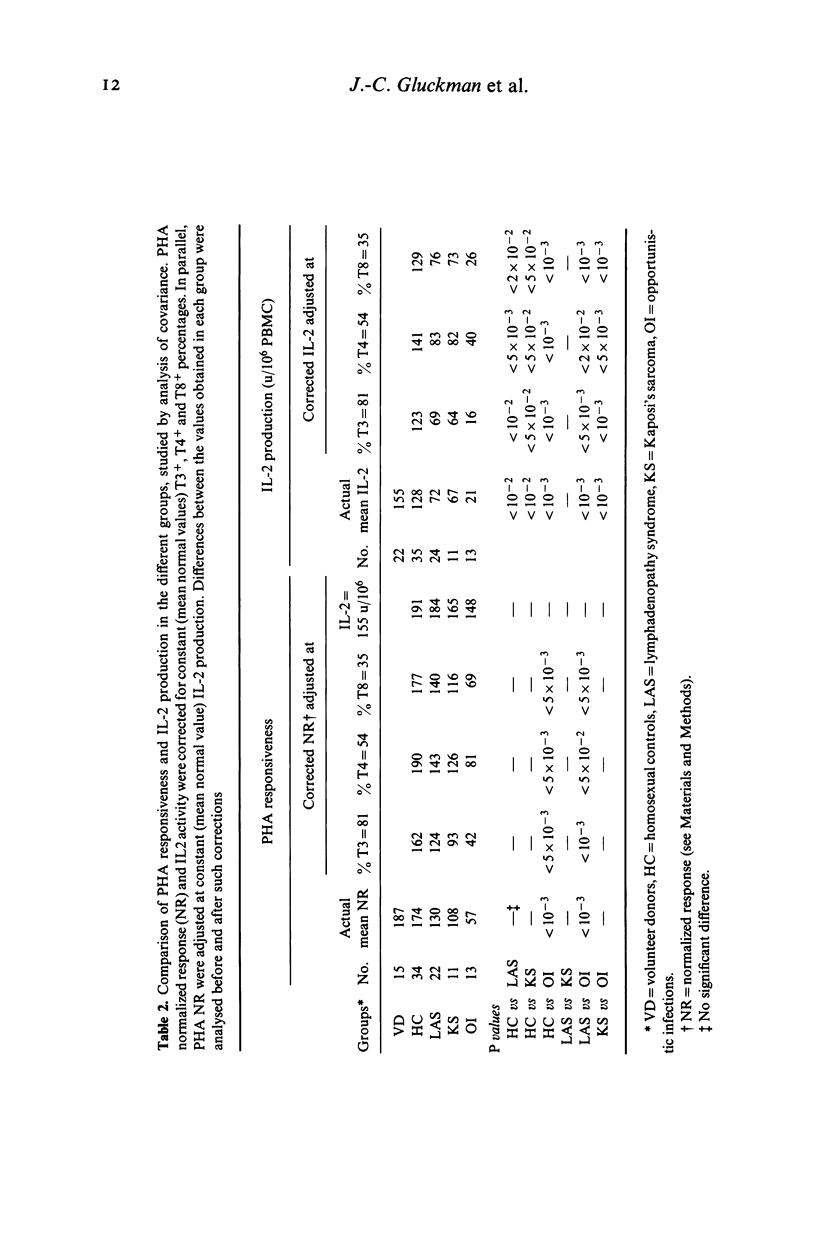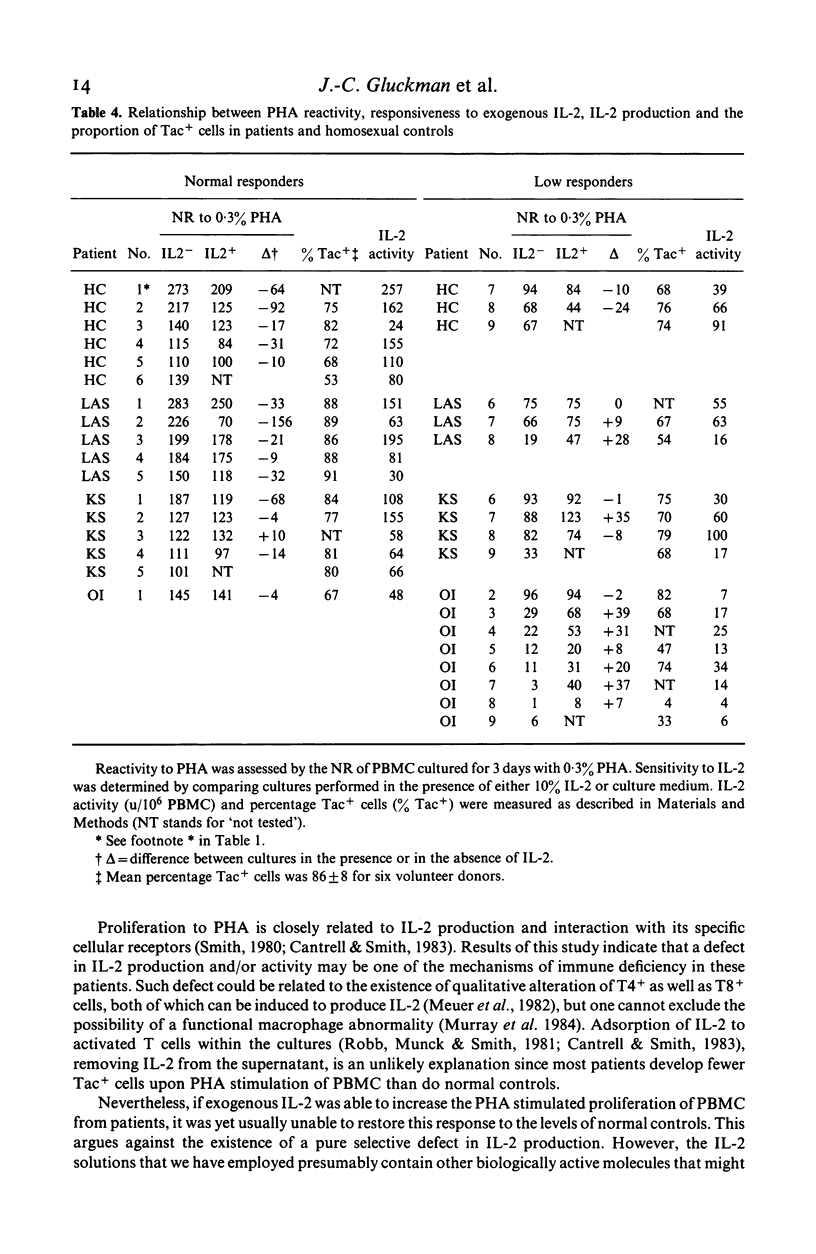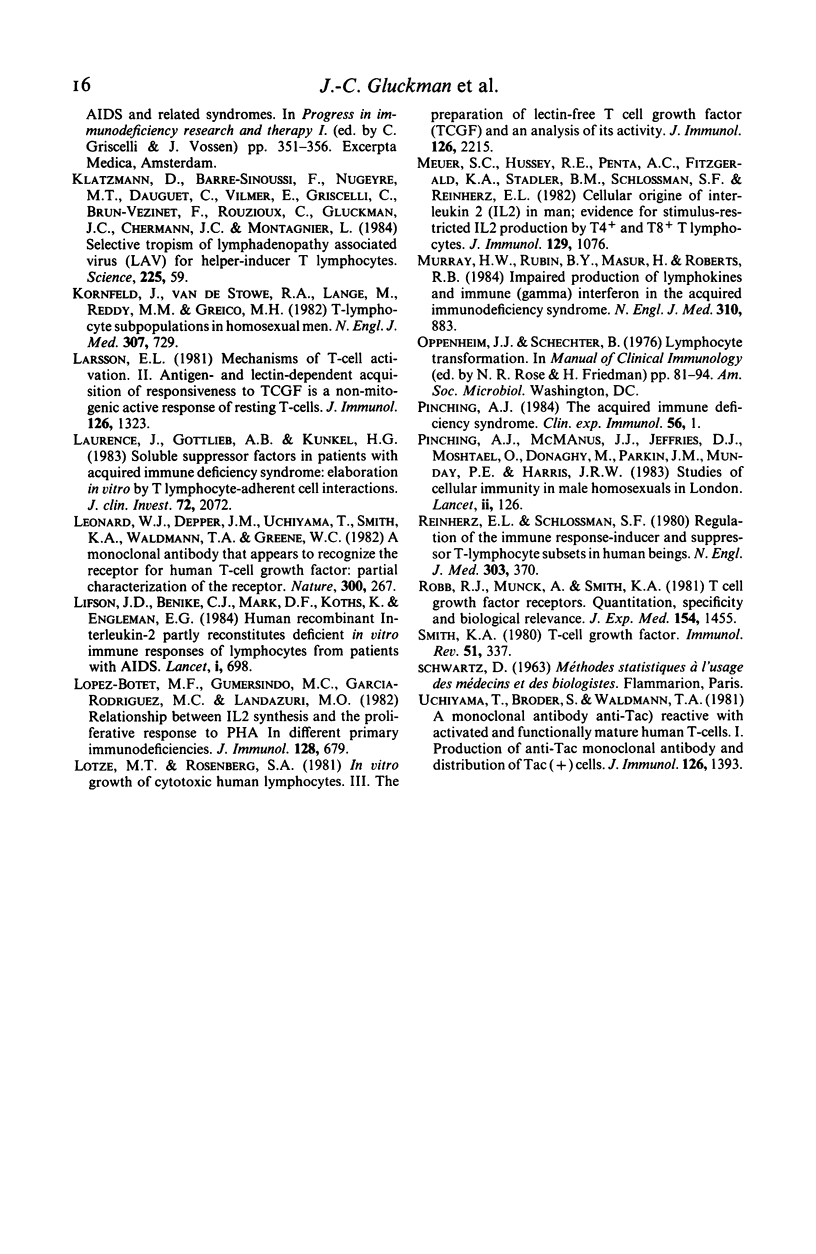Abstract
We have investigated the respective role of quantitative T lymphocyte subset abnormalities, interleukin-2 (IL-2) production and responsiveness to IL-2, in the proliferative deficiency that is observed in acquired immune deficiency syndrome (AIDS) and Lymphadenopathy syndrome (LAS) patients or even in some apparently healthy male homosexuals. 83 subjects were evaluated: 35 symptom free male homosexuals (HC), 24 LAS and 24 AIDS patients. As expected, many HC and most patients presented with T lymphocyte subset imbalance. These quantitative defects were associated with decreased reactivity to PHA and reduced production of IL-2 by PHA stimulated lymphocytes. No correlation however could be found between these two functions and variations in the T lymphocyte subset distribution. On the other hand, PHA responsiveness appeared to closely depend on IL-2 activity. Addition of exogenous IL-2 to lymphocytes from patients with low proliferative responses, stimulated with suboptimal PHA concentration, enhanced proliferation in some but not all the cases. In most instances this increase never reached the levels observed with similarly treated cells from normal individuals. In these patients, the limited number of lymphocytes which express IL-2 receptors upon PHA stimulation may explain both low PHA reactivity and reduced IL-2 responsiveness. These data indicate some possible mechanisms of immunodeficiency in AIDS and LAS.
Full text
PDF








Selected References
These references are in PubMed. This may not be the complete list of references from this article.
- Ammann A. J., Abrams D., Conant M., Chudwin D., Cowan M., Volberding P., Lewis B., Casavant C. Acquired immune dysfunction in homosexual men: immunologic profiles. Clin Immunol Immunopathol. 1983 Jun;27(3):315–325. doi: 10.1016/0090-1229(83)90084-3. [DOI] [PubMed] [Google Scholar]
- Barré-Sinoussi F., Chermann J. C., Rey F., Nugeyre M. T., Chamaret S., Gruest J., Dauguet C., Axler-Blin C., Vézinet-Brun F., Rouzioux C. Isolation of a T-lymphotropic retrovirus from a patient at risk for acquired immune deficiency syndrome (AIDS). Science. 1983 May 20;220(4599):868–871. doi: 10.1126/science.6189183. [DOI] [PubMed] [Google Scholar]
- Brun-Vezinet F., Rouzioux C., Barre-Sinoussi F., Klatzmann D., Saimot A. G., Rozenbaum W., Christol D., Gluckmann J. C., Montagnier L., Chermann J. C. Detection of IgG antibodies to lymphadenopathy-associated virus in patients with AIDS or lymphadenopathy syndrome. Lancet. 1984 Jun 9;1(8389):1253–1256. doi: 10.1016/s0140-6736(84)92444-9. [DOI] [PubMed] [Google Scholar]
- Cantrell D. A., Smith K. A. Transient expression of interleukin 2 receptors. Consequences for T cell growth. J Exp Med. 1983 Dec 1;158(6):1895–1911. doi: 10.1084/jem.158.6.1895. [DOI] [PMC free article] [PubMed] [Google Scholar]
- Cavaille-Coll M., Brisson E., Klatzmann D., Gluckman J. C. Exogenous interleukin-2 and mitogen responses in AIDS patients. Lancet. 1984 Jun 2;1(8388):1245–1245. doi: 10.1016/s0140-6736(84)91733-1. [DOI] [PubMed] [Google Scholar]
- Cavaille-Coll M., Messiah A., Klatzmann D., Rozenbaum W., Lachiver D., Kernbaum S., Brisson E., Chapuis F., Blanc C., Debre P. Critical analysis of T cell subset and function evaluation in patients with persistent generalized lymphadenopathy in groups at risk for AIDS. Clin Exp Immunol. 1984 Sep;57(3):511–519. [PMC free article] [PubMed] [Google Scholar]
- Chouaib S., Fradelizi D. The mechanism of inhibition of human IL 2 production. J Immunol. 1982 Dec;129(6):2463–2468. [PubMed] [Google Scholar]
- Ciobanu N., Welte K., Kruger G., Venuta S., Gold J., Feldman S. P., Wang C. Y., Koziner B., Moore M. A., Safai B. Defective T-cell response to PHA and mitogenic monoclonal antibodies in male homosexuals with acquired immunodeficiency syndrome and its in vitro correction by interleukin 2. J Clin Immunol. 1983 Oct;3(4):332–340. doi: 10.1007/BF00915794. [DOI] [PubMed] [Google Scholar]
- Copelan E. A., Rinehart J. J., Lewis M., Mathes L., Olsen R., Sagone A. The mechanism of retrovirus suppression of human T cell proliferation in vitro. J Immunol. 1983 Oct;131(4):2017–2020. [PubMed] [Google Scholar]
- Gillis S., Ferm M. M., Ou W., Smith K. A. T cell growth factor: parameters of production and a quantitative microassay for activity. J Immunol. 1978 Jun;120(6):2027–2032. [PubMed] [Google Scholar]
- Klatzmann D., Barré-Sinoussi F., Nugeyre M. T., Danquet C., Vilmer E., Griscelli C., Brun-Veziret F., Rouzioux C., Gluckman J. C., Chermann J. C. Selective tropism of lymphadenopathy associated virus (LAV) for helper-inducer T lymphocytes. Science. 1984 Jul 6;225(4657):59–63. doi: 10.1126/science.6328660. [DOI] [PubMed] [Google Scholar]
- Kornfeld H., Vande Stouwe R. A., Lange M., Reddy M. M., Grieco M. H. T-lymphocyte subpopulations in homosexual men. N Engl J Med. 1982 Sep 16;307(12):729–731. doi: 10.1056/NEJM198209163071206. [DOI] [PubMed] [Google Scholar]
- Larsson E. L. Mechanism of T cell activation. II. Antigen- and lectin-dependent acquisition of responsiveness to TCGF is a nonmitogenic, active response of resting T cells. J Immunol. 1981 Apr;126(4):1323–1326. [PubMed] [Google Scholar]
- Laurence J., Gottlieb A. B., Kunkel H. G. Soluble suppressor factors in patients with acquired immune deficiency syndrome and its prodrome. Elaboration in vitro by T lymphocyte-adherent cell interactions. J Clin Invest. 1983 Dec;72(6):2072–2081. doi: 10.1172/JCI111172. [DOI] [PMC free article] [PubMed] [Google Scholar]
- Leonard W. J., Depper J. M., Uchiyama T., Smith K. A., Waldmann T. A., Greene W. C. A monoclonal antibody that appears to recognize the receptor for human T-cell growth factor; partial characterization of the receptor. Nature. 1982 Nov 18;300(5889):267–269. doi: 10.1038/300267a0. [DOI] [PubMed] [Google Scholar]
- Lifson J. D., Benike C. J., Mark D. F., Koths K., Engleman E. G. Human recombinant interleukin-2 partly reconstitutes deficient in-vitro immune responses of lymphocytes from patients with AIDS. Lancet. 1984 Mar 31;1(8379):698–702. doi: 10.1016/s0140-6736(84)92220-7. [DOI] [PubMed] [Google Scholar]
- Lotze M. T., Rosenberg S. A. In vitro growth of cytotoxic human lymphocytes. III. The preparation of lectin-free T cell growth factor (TCGF) and an analysis of its activity. J Immunol. 1981 Jun;126(6):2215–2220. [PubMed] [Google Scholar]
- López-Botet M., Fontán G., Garcia Rodriguez M. C., de Landázuri M. O. Relationship between IL 2 synthesis and the proliferative response to PHA in different primary immunodeficiencies. J Immunol. 1982 Feb;128(2):679–683. [PubMed] [Google Scholar]
- Meuer S. C., Hussey R. E., Penta A. C., Fitzgerald K. A., Stadler B. M., Schlossman S. F., Reinherz E. L. Cellular origin of interleukin 2 (IL 2) in man: evidence for stimulus-restricted IL 2 production by T4+ and T8+ T lymphocytes. J Immunol. 1982 Sep;129(3):1076–1079. [PubMed] [Google Scholar]
- Murray H. W., Rubin B. Y., Masur H., Roberts R. B. Impaired production of lymphokines and immune (gamma) interferon in the acquired immunodeficiency syndrome. N Engl J Med. 1984 Apr 5;310(14):883–889. doi: 10.1056/NEJM198404053101404. [DOI] [PubMed] [Google Scholar]
- Pinching A. J., McManus T. J., Jeffries D. J., Moshtael O., Donaghy M., Parkin J. M., Munday P. E., Harris J. R. Studies of cellular immunity in male homosexuals in London. Lancet. 1983 Jul 16;2(8342):126–130. doi: 10.1016/s0140-6736(83)90115-0. [DOI] [PubMed] [Google Scholar]
- Pinching A. J. The acquired immune deficiency syndrome. Clin Exp Immunol. 1984 Apr;56(1):1–13. [PMC free article] [PubMed] [Google Scholar]
- Reinherz E. L., Schlossman S. F. Current concepts in immunology: Regulation of the immune response--inducer and suppressor T-lymphocyte subsets in human beings. N Engl J Med. 1980 Aug 14;303(7):370–373. doi: 10.1056/NEJM198008143030704. [DOI] [PubMed] [Google Scholar]
- Robb R. J., Munck A., Smith K. A. T cell growth factor receptors. Quantitation, specificity, and biological relevance. J Exp Med. 1981 Nov 1;154(5):1455–1474. doi: 10.1084/jem.154.5.1455. [DOI] [PMC free article] [PubMed] [Google Scholar]
- Smith K. A. T-cell growth factor. Immunol Rev. 1980;51:337–357. doi: 10.1111/j.1600-065x.1980.tb00327.x. [DOI] [PubMed] [Google Scholar]


